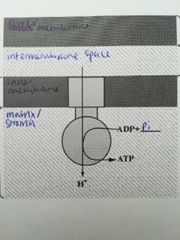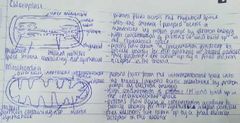![]()
![]()
![]()
Use LEFT and RIGHT arrow keys to navigate between flashcards;
Use UP and DOWN arrow keys to flip the card;
H to show hint;
A reads text to speech;
13 Cards in this Set
- Front
- Back
- 3rd side (hint)
|
What is ATP known as? |
universal energy currency |
|
|
|
Why is ATP known as universal energy currency? |
It is the energy used for all reactions in all cells |
|
|
|
What is ATP? |
A nucleotide |
|
|
|
Advantages of ATP |
Soluble, easily transported, releases energy efficiently, smaller amounts of energy can be stored than in glucose, inert |
5 |
|
|
ATP structure |

X = high energy terminal bonds |
|
|
|
What enzyme can hydrolyse the high energy terminal bond between the middle and last phosphate group? |
ATPase |
|
|
|
What does ATPase achieve? |
By hydrolysing the high energy terminal bond in between the phosphate groups, energy is released in usable amounts so little is wasted in heat |
|
|
|
How can ATP be reformed? |
Phosphorylation (phosphate group added) of ADP during condensation reaction ADP + Pi = ATP |
|
|
|
Where does ATP synthesis take place? |
On the internal membranes of mitochondria and chloroplasts |
|
|
|
Describe ATP synthesis |

Occurs via chemiosmosis which is the flow of protons down an electrochemical gradient, through the enzyme ATP synthetase (found within stalked particles of the inner membranes) to provide the potential energy needed to synthesise ATP by phosphorylation |
|
|
|
Advantages of ATP over glucose |
- Hydrolysis of ATP into ADP + Pi releases energy into small, manageable bursts - Hydrolysis of ATP to ADP + Pi is a single reaction unlike the breakdown of glucose which requires a long series of reactions |
|
|
|
Compare the Chloroplast to the Mitochondria |

|
|
|
|
Describe the role of the ETC in ATP synthesis |
High energy electrons pass from one electron carrier to the next, providing electron energy to drive proton pumps. Protons are pumped into the inner membrane/thylakoid membranes. The proton gradient allows protons to pass back into the matrix/stroma via ATP synthetase. The electrochemical gradient provides energy for the oxidative phosphorylation (oxygen is final acceptor) of ADP to ATP (chemiosmosis) |
|

